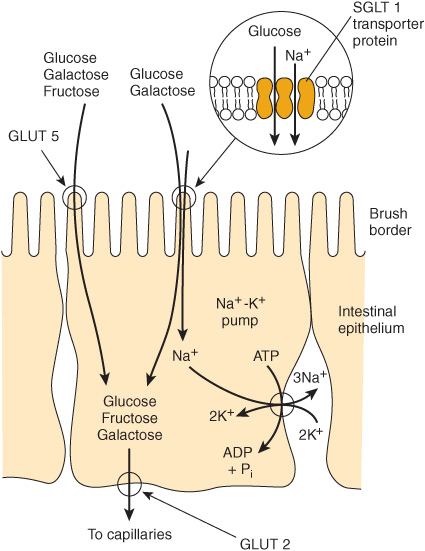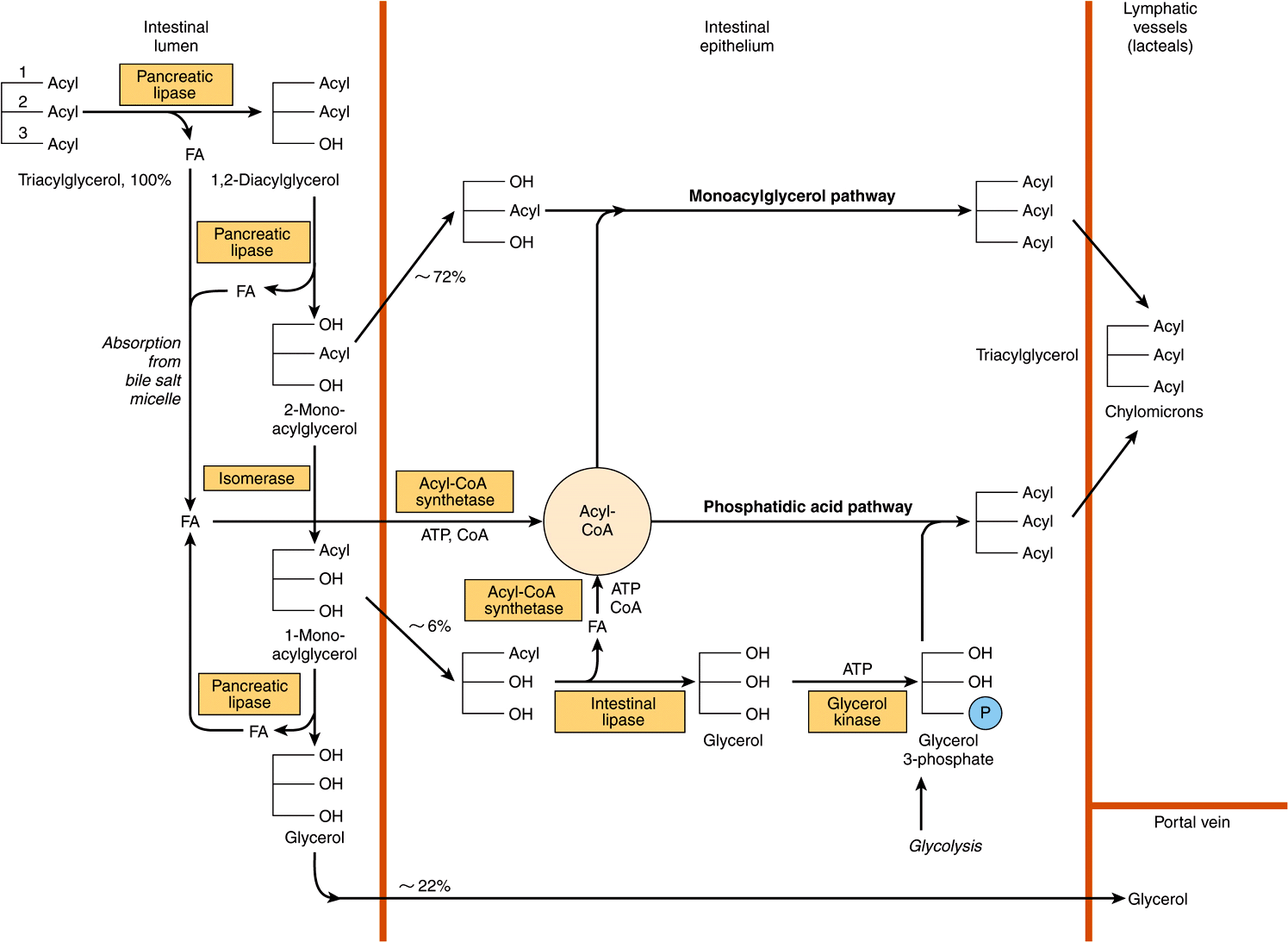43
Nutrition, Digestion, & Absorption
David A. Bender, PhD & Peter A. Mayes, PhD, DSc
OBJECTIVES
After studying this chapter, you should be able to:
![]() Describe the digestion and absorption of carbohydrates, lipids, proteins, vitamins, and minerals.
Describe the digestion and absorption of carbohydrates, lipids, proteins, vitamins, and minerals.
![]() Explain how energy requirements can be measured and estimated and how measuring the respiratory quotient permits estimation of the mix of metabolic fuels being oxidized.
Explain how energy requirements can be measured and estimated and how measuring the respiratory quotient permits estimation of the mix of metabolic fuels being oxidized.
![]() Describe the consequences of undernutrition: marasmus, cachexia, and kwashiorkor.
Describe the consequences of undernutrition: marasmus, cachexia, and kwashiorkor.
![]() Explain how protein requirements are determined and why more of some proteins than others is required to maintain nitrogen balance.
Explain how protein requirements are determined and why more of some proteins than others is required to maintain nitrogen balance.
BIOMEDICAL IMPORTANCE
In addition to water, the diet must provide metabolic fuels (mainly carbohydrates and lipids), protein (for growth and turnover of tissue proteins, as well as a source of metabolic fuel), fiber (for bulk in the intestinal lumen), minerals (containing elements with specific metabolic functions), and vitamins and essential fatty acids (organic compounds needed in smaller amounts for other metabolic and physiologic functions). The polysaccharides, triacylglycerols, and proteins that make up the bulk of the diet must be hydrolyzed to their constituent monosaccharides, fatty acids, and amino acids, respectively, before absorption and utilization. Minerals and vitamins must be released from the complex matrix of food before they can be absorbed and utilized.
Globally, undernutrition is widespread, leading to impaired growth, defective immune systems, and reduced work capacity. By contrast, in developed countries, there is excessive food consumption (especially of fat), leading to obesity, and the development of diabetes, cardiovascular disease, and some cancers. Deficiencies of vitamin A, iron, and iodine pose major health concerns in many countries, and deficiencies of other vitamins and minerals are a major cause of ill health. In developed countries nutrient deficiency is rare, although there are vulnerable sections of the population at risk. Intakes of minerals and vitamins that are adequate to prevent deficiency may be inadequate to promote optimum health and longevity.
Excessive secretion of gastric acid, associated with Helicobacter pylori infection, can result in the development of gastric and duodenal ulcers; small changes in the composition of bile can result in crystallization of cholesterol as gallstones; failure of exocrine pancreatic secretion (as in cystic fibrosis) leads to undernutrition and steatorrhea. Lactose intolerance is the result of lactase deficiency, leading to diarrhea and intestinal discomfort when lactose is consumed. Absorption of intact peptides that stimulate antibody responses causes allergic reactions; celiac disease is an allergic reaction to wheat gluten.
DIGESTION & ABSORPTION OF CARBOHYDRATES
The digestion of carbohydrates is by hydrolysis to liberate oligosaccharides, then free mono- and disaccharides. The increase in blood glucose after a test dose of a carbohydrate compared with that after an equivalent amount of glucose (as glucose or from a reference starchy food) is known as the glycemic index. Glucose and galactose have an index of 1 (or 100%), as do lactose, maltose, isomaltose, and trehalose, which give rise to these monosaccharides on hydrolysis. Fructose and the sugar alcohols are absorbed less rapidly and have a lower glycemic index, as does sucrose. The glycemic index of starch varies between near 1 (or 100%) to near 0 as a result of variable rates of hydrolysis, and that of nonstarch polysaccharides is 0. Foods that have a low glycemic index are considered to be more beneficial since they cause less fluctuation in insulin secretion. Resistant starch and nonstarch polysaccharides provide substrates for bacterial fermentation in the large intestine, and the resultant butyrate and other short chain fatty acids provide a significant source of fuel for intestinal enterocytes. There is some evidence that butyrate also has antiproliferative activity, and so provides protection against colorectal cancer.
Amylases Catalyze the Hydrolysis of Starch
The hydrolysis of starch is catalyzed by salivary and pancreatic amylases, which catalyze random hydrolysis of α(1—4) glycoside bonds, yielding dextrins, then a mixture of glucose, maltose, and maltotriose and small branched dextrins (from the branchpoints in amylopectin).
Disaccharidases Are Brush Border Enzymes
The disaccharidases, maltase, sucrase-isomaltase (a bifunctional enzyme catalyzing hydrolysis of sucrose and isomaltose), lactase, and trehalase are located on the brush border of the intestinal mucosal cells, where the resultant monosaccharides and those arising from the diet are absorbed. Congenital deficiency of lactase occurs rarely in infants, leading to lactose intolerance and failure to thrive when fed on breast milk or normal infant formula. Congenital deficiency of sucrase-isomaltase occurs among the Inuit, leading to sucrose intolerance, with persistent diarrhea and failure to thrive when the diet contains sucrose.
In most mammals, and most human beings, lactase activity begins to fall after weaning and is almost completely lost by late adolescence, leading to lactose intolerance. Lactose remains in the intestinal lumen, where it is a substrate for bacterial fermentation to lactate, resulting in abdominal discomfort and diarrhea after consumption of relatively large amounts. In two population groups, people of north European origin and nomadic tribes of sub-Saharan Africa and Arabia, lactase persists after weaning and into adult life. Marine mammals secrete a high-fat milk that contains no carbohydrate, and their pups lack lactase.
There Are Two Separate Mechanisms for the Absorption of Monosaccharides in the Small Intestine
Glucose and galactose are absorbed by a sodium-dependent process. They are carried by the same transport protein (SGLT 1) and compete with each other for intestinal absorption (Figure 43–1). Other monosaccharides are absorbed by carrier-mediated diffusion. Because they are not actively transported, fructose and sugar alcohols are only absorbed down their concentration gradient, and after a moderately high intake, some may remain in the intestinal lumen, acting as a substrate for bacterial fermentation. Large intakes of fructose and sugar alcohols can lead to osmotic diarrhea.
FIGURE 43–1 Transport of glucose, fructose, and galactose across the intestinal epithelium. The SGLT 1 transporter is coupled to the Na+-K+ pump, allowing glucose and galactose to be transported against their concentration gradients. The GLUT 5 Na+-independent facilitative transporter allows fructose, as well as glucose and galactose, to be transported down their concentration gradients. Exit from the cell for all sugars is via the GLUT 2 facilitative transporter.
DIGESTION & ABSORPTION OF LIPIDS
The major lipids in the diet are triacylglycerols and, to a lesser extent, phospholipids. These are hydrophobic molecules and have to be hydrolyzed and emulsified to very small droplets (micelles, 4-6 nm in diameter) before they can be absorbed. The fat-soluble vitamins, A, D, E, and K, and a variety of other lipids (including cholesterol) are absorbed dissolved in the lipid micelles. Absorption of fat-soluble vitamins is impaired on a very low fat diet.
Hydrolysis of triacylglycerols is initiated by lingual and gastric lipases, which attack the sn-3 ester bond forming 1,2-diacylglycerols and free fatty acids, which act as emulsifying agents. Pancreatic lipase is secreted into the small intestine and requires a further pancreatic protein, colipase, for activity. It is specific for the primary ester links—ie, positions 1 and 3 in triacylglycerols—resulting in 2-monoacylglycerols and free fatty acids as the major end products of luminal triacylglycerol digestion. Pancreatic esterase in the intestinal lumen hydrolyzes monoacylglycerols, but they are poor substrates, and only ~25% of ingested triacylglycerol is completely hydrolyzed to glycerol and fatty acids before absorption (Figure 43–2). Bile salts, formed in the liver and secreted in the bile, permit emulsification of the products of lipid digestion into micelles together with dietary phospholipids and cholesterol secreted in the bile (about 2 g/day) as well as dietary cholesterol (about 0.5 g/day). Because the micelles are soluble, they allow the products of digestion, including the fat-soluble vitamins, to be transported through the aqueous environment of the intestinal lumen to come into close contact with the brush border of the mucosal cells, allowing uptake into the epithelium. The bile salts remain in the intestinal lumen, where most are absorbed from the ileum into the enterohepatic circulation (Chapter 26). Within the intestinal epithelium, 1-monoacyglycerols are hydrolyzed to fatty acids and glycerol and 2-monoacylglycerols are reacylated to triacylglycerols via the monoacylglycerol pathway. Glycerol released in the intestinal lumen is absorbed into the hepatic portal vein; glycerol released within the epithelium is reutilized for triacylglycerol synthesis via the normal phosphatidic acid pathway (Chapter 24). Long-chain fatty acids are esterified to yield to triacylglycerol in the mucosal cells and together with the other products of lipid digestion, secreted as chylomicrons into the lymphatics, entering the bloodstream via the thoracic duct (Chapter 25). Short- and medium-chain fatty acids are mainly absorbed into the hepatic portal vein as free fatty acids.
FIGURE 43–2 Digestion and absorption of triacylglycerols. The values given for percentage uptake may vary widely but indicate the relative importance of the three routes shown.
Cholesterol is absorbed dissolved in lipid micelles and is mainly esterified in the intestinal mucosa before being incorporated into chylomicrons. Plant sterols and stanols (in which the B ring is saturated) compete with cholesterol for esterification, but are poor substrates, so that there is an increased amount of unesterified cholesterol in the mucosal cells. Unesterified cholesterol and other sterols are actively transported out of the mucosal cells into the intestinal lumen. This means that plant sterols and stanols effectively inhibit the absorption of not only dietary cholesterol, but also the larger amount that is secreted in the bile, so lowering the whole body cholesterol content, and hence the plasma cholesterol concentration.
DIGESTION & ABSORPTION OF PROTEINS
Native proteins are resistant to digestion because few peptide bonds are accessible to the proteolytic enzymes without prior denaturation of dietary proteins (by heat in cooking and by the action of gastric acid).
Several Groups of Enzymes Catalyze the Digestion of Proteins
There are two main classes of proteolytic digestive enzymes (proteases), with different specificities for the amino acids forming the peptide bond to be hydrolyzed. Endopeptidases
Stay updated, free articles. Join our Telegram channel

Full access? Get Clinical Tree




